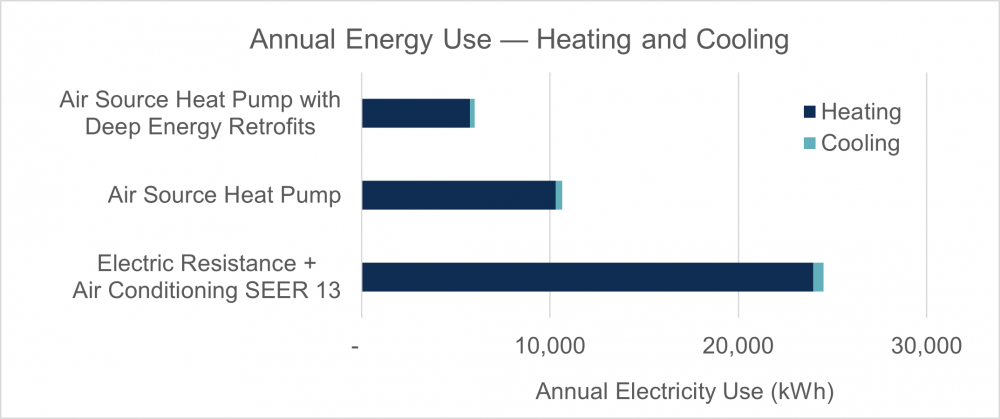CEE research staff modeled cold-climate heat pump performance across a typical Minnesota winter and summer to understand their impacts on energy use and the electricity grid. This post explores some of the key takeaways of that research—read to the end for a summary of methods and assumptions.
Heat pumps save significant energy over their electric counterparts.
Heat pumps are first and foremost an energy efficiency opportunity. A household will save energy when it switches to a heat pump from traditional electric heating and cooling. For a typical Minnesota home, a heat pump will reduce electricity use by 55%, mostly in heating. Coupled with deep energy retrofits to the house shell (see the assumptions section below), electricity use drops by more than 75%.

Heat pumps will lower summer peak demand.
Electricity demand in Minnesota is the highest during summer heat waves, driven by cooling loads. More efficient heat pumps replacing central air conditioners will lower the energy demand per household by approximately 10%. Combining a heat pump with deep energy retrofits lowers peak demand by more than half.

In Minnesota, 70% of households have central air conditioning. Replacing those ACs with a heat pump in single-family households (to correspond with the energy use shown above) would lower the summer peak by 520 Megawatts (MW).
Heat pumps will increase energy demand in the winter — but they’re still a win for energy efficiency.
Unlike propane or natural gas, electricity cannot be stored inexpensively, which creates additional concern around demand occurring during a system peak. In Minnesota, 78% of homes are heated with natural gas, oil, or propane, so a transition to electricity as the primary heating fuel will inevitably increase winter electricity demand.
However, certain dynamics will moderate those winter peaks. On typical, moderate climate days, heat pumps will reduce peak demand from electric resistance heat by over 60%. Given the high load of electric resistance heat, this can save approximately 4 kilowatts (kW) per home. In other words, heat pumps reduce winter peaks of traditional electric technologies approximately 10 times more than they reduce summer peaks. It also means that for every electric resistance home converted to a heat pump, two fossil fuel homes (e.g. natural gas or propane) can convert to a heat pump with no net effect on peak demand.

In Minnesota, 8% of single-family households heat with electricity. Replacing all these homes’ electric systems with heat pumps would lower demand on moderate days by 570 MW.
It is important to plan for cold snaps — days with temperatures falling below -10°F, when some utilities experience peak demand on their system. However, most of today’s heat pumps require backup systems to operate on such cold days. If a home has electric resistance heat as a backup, the demand will be the same whether the home has a heat pump or not. However, nonelectric backup systems can moderate this effect and increase a household’s resilience in withstanding cold weather days.
